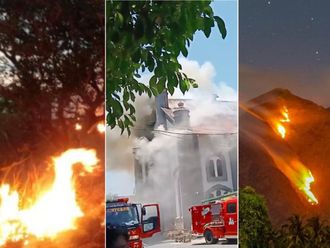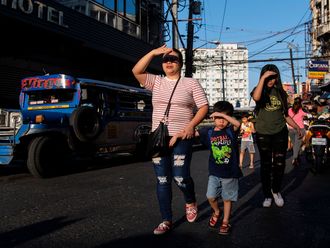TACLOBAN, Philippines: Pope Francis arrived on Saturday in the central Philippines for what is expected to be an emotional day with survivors of a catastrophic super typhoon that claimed thousands of lives 14 months ago.
Francis flew in from the national capital of Manila to Tacloban, one of the worst-hit cities, to be greeted by tens of thousands of people, but also wet and windy weather.
A giant crowd had gathered overnight to welcome the pontiff and hear him deliver Mass at the airport, and the sea of people in thin yellow raincoats handed out by organisers chanted: ‘Long live the Pope’ as he arrived.
It echoed the rapturous reception that millions of Filipinos gave the pontiff during the first two days of his trip to the country, reinforcing its status as the Catholic Church’s bastion in Asia.
Francis’s five-day visit is partly aimed at helping the Church expand its influence throughout the region, but he made clear that visiting survivors of Super Typhoon Haiyan was also a top priority.
“In a particular way, this visit is meant to express my closeness to our brothers and sisters who endured the suffering, loss and devastation caused by Typhoon Yolanda,” Francis said in the nation’s capital on Friday, referring to Haiyan by its local name.
Haiyan, the strongest storm ever recorded on land, left 7,350 people dead or missing in November 2013 as it devastated fishing and farming towns on central islands that were already among the Philippines’ poorest.
Fourteen months later, many of those communities are still struggling to recover, with the rubble of destroyed buildings laying in piles and millions of felled coconut trees strewn across idle farmland.
Tsunami-like waves washed away entire villages within a few kilometres from the Tacloban airport, where the Pope was to deliver Mass, and people are still living nearby in temporary shelters.
“Seeing the Pope would be like being face-to-face with Christ,” Teresita Raza, 65, who camped overnight to get a good spot to see him during the mass, told AFP.
“His presence will be of great comfort to those affected by calamities. He will help ease their burden.”
The Pope was due to spend the day in the typhoon-hit areas in and around Tacloban.
However intense rain was forecast to fall across the region throughout Saturday.
Local organisers told the crowd the event at the airport would be cut short because of the weather, with the Pope to say a Mass but not give communion personally.
There was no immediate news on whether the rest of his day, in which he was scheduled to have lunch with 30 survivors, and visit one of the area’s big churches, would continue as planned.
The Philippines endures an average of about 20 major storms a year, many of them deadly.
But the unprecedented strength of Haiyan, with winds of 315 kilometres an hour, was an extreme weather event consistent with man-made climate change, the United Nations’ weather agency and scientists have said.
As he flew from Sri Lanka to the Philippines on Thursday, the pope again raised his concern about climate change, as he called on world leaders to be more “courageous” in trying to unite to fight it.
On Friday, the Pope weighed into controversial political waters, using his first major speech of the trip to demand Philippine leaders resist corruption and end the nation’s “scandalous social inequalities”.
“It is now, more than ever, necessary that political leaders be outstanding for honesty, integrity and commitment to the common good,” the Pope said in the speech at the presidential palace.
He challenged “everyone, at all levels of society, to reject every form of corruption, which diverts resources from the poor”.
Philippine President Benigno Aquino has waged a high-profile campaign against corruption since coming to power in 2010 that has seen his predecessor and three senators detained.
But critics of Aquino have accused him of focusing his anti-graft campaign only on opponents and not allies, and point out poverty has barely improved in recent years despite strong economic growth.
About 25 million Filipinos, or one quarter of the population, live on the equivalent of 60 cents a day or less, according to government data.
The Philippines has long been the Church’s stronghold in the region, with Catholics accounting for 80 per cent of the former Spanish colony’s population.
Massive crowds gathered along the pontiff’s motorcade routes during his first two days in the country.
Pope-mania will reach a peak on Sunday, with organisers expecting him to attract as many as six million people for mass at a Manila park.
If as big as expected, the crowd will surpass the previous record for a papal gathering of five million during a mass by John Paul II at the same venue in 1995.











